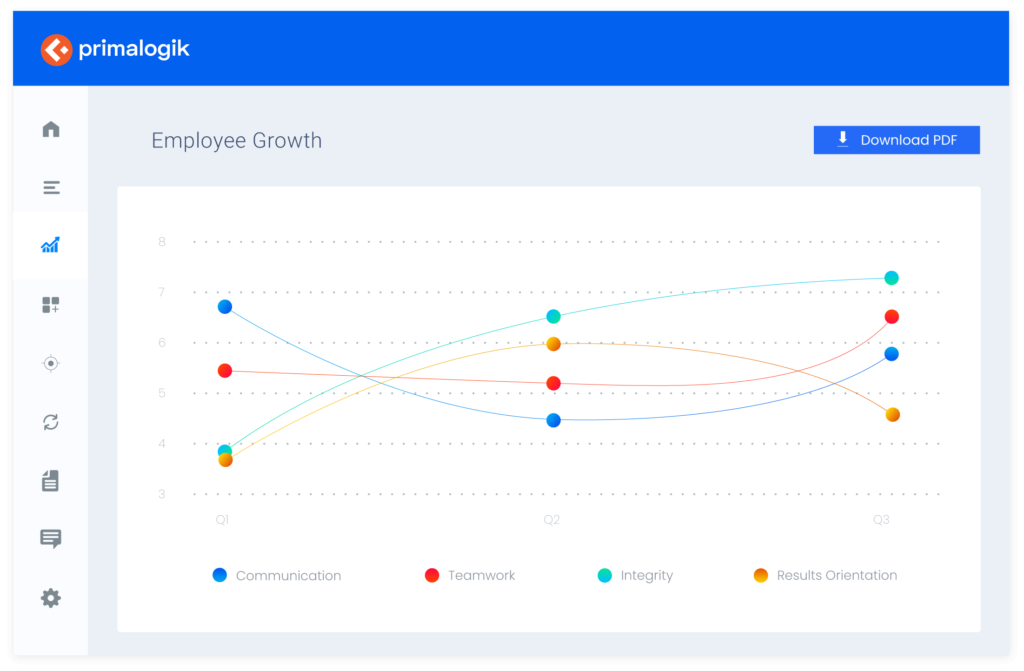Have you ever noticed someone get anxious before a performance review? That’s pretty common. Managers get nervous about them as well. Maybe they were caught off guard by a past employee evaluation. A previous manager may have voiced unexpected and negative criticism.
First, reassure your employees that evaluations are meant to help them grow.
Let’s look at what the employee evaluation involves. We’ll also discuss how to deliver them in a way that centres on the employee experience. As a result, employees will look forward to their evaluations. Anxiety will no longer be a concern either. And best of all, it will promote learning.
Navigation
1. What Is an Employee Evaluation?
2. Types of Employee Evaluations
3. Best Practices for an Employee Evaluation
What Is an Employee Evaluation?
The employee evaluation is a formal check-in that happens periodically. Often called an appraisal or review, it follows a standardized process. Managers across an organization should us the same evaluation process and schedule. This ensures fairness. For instance, some organizations deliver evaluations quarterly or every six months.
How is an employee evaluation used?
First and foremost, the employee evaluation helps you evaluate progress toward goals. Second, it can help with decisions about promotions and raises. That’s why having a standardized process is so important. It helps leaders and HR make fair and accurate decisions.
How do employees benefit from evaluations?

Evaluations show employees where to focus their efforts. It also provides a thorough review of their progress in critical areas. Plus, it helps managers decide what training to provide. Employees will then engage in learning opportunities in important areas for growth. Lastly, they’ll have the satisfaction of knowing where they’re excelling.
Types of Employee Evaluations
Now, let’s explore several methods of evaluating employees. Common types of rating scales will follow. The method of evaluation shows whose perspective you’re gaining. The rating scale tells you how that person evaluates the employee.
Employee Evaluation Methods
The following are five popular types of employee evaluations. Each has potential benefits. You may even use more than one in a single performance review.
Self-assessment
An employee can complete a self-assessment before the formal evaluation. This can serve two purposes. First, it can illuminate any strengths or challenges the manager hasn’t noticed. Second, it can highlight the employee’s level of self-awareness.
Comparing it against the manager’s evaluation shows whether the employee knows where to improve. SHRM offers a free self-assessment template.
Team assessment
The team evaluation assesses teams’ overall success. It pinpoints areas for improvement as well. Team members also evaluate individual peers’ performance. The manager then gathers feedback for each individual from these reviews. The Schreyer Institute for Teaching Excellence of Penn State provides a template for team evaluations.
This thorough guide offers questions on individual and team performance.
Manager’s assessment
This is the most common type of employee evaluation. It provides the manager’s observations on the employee’s performance throughout the review period. The manager writes a formal evaluation and discusses it with the employee. The two types of reviews discussed above can complement the manager’s evaluation.
Leader assessment
This type of evaluation assesses an individual’s skill as a leader. It considers competencies like strategic thinking and the ability to motivate people. The leader assessment often includes reviews by employees as well as senior leaders. Soliciting input from direct reports helps reveal how effectively this individual can lead.
Meanwhile, senior leaders can evaluate outcomes—another piece of the puzzle. This process can assist in promoting leaders to suitable positions.
360-degree assessment
In this evaluation method, a broad range of people evaluates an employee. The 360 assessment shouldn’t be directly used in formal performance reviews. Instead, it should be used strictly for developmental purposes.
Avoid conducting it at the same time that managers are delivering formal reviews. That will ensure that employees don’t perceive it as connected to those reviews. Plus, it won’t unintentionally influence managers’ evaluations. However, a 360 conducted earlier in the review period can highlight areas for growth that the manager can observe over time.
Employee Evaluation Rating Scales
You also have several types of rating scales to choose from. Each of the scales discussed below is a method of evaluating employees. They can be used with any of the assessments described above.
Regardless of the scale you choose, provide clear direction on how to use it.
“Raters should be provided with examples of behaviours, skills, measurements, and other data that will assist them in deciding the performance level,” says SHRM. “This level of detail is particularly important in numerical scales, where one person’s ‘5’ is another person’s ‘4.’”
Five-point scales are commonly used. However, managers often focus on the centre of the scale. Using a scale with 4 or 6 levels can decrease that tendency, SHRM notes. After all, they offer no “middle” option.
Graphic rating scale
With this scale, the reviewer ranks the employee’s performance on a continuum. The scale usually includes numerous questions on topics like teamwork and communication. Ratings may include numbers (1 to 5) or descriptive words (“unsatisfactory” to “excellent”).
It’s a simple type of scale that often has a strong visual element. For instance, it could include a numbered bar where the manager marks the appropriate spot. It could also include a row of boxes, allowing the manager to check the right one.
Forced choice
Forced choice rating scales ask managers to compare employees against each other. For each criterium on the scale, they rank employees in order of performance. However, this type of scale tends to undermine culture and camaraderie. Plus, it forces employees to make distinctions where no difference may exist. Most experts today advise avoiding forced choice rankings.
Management by objectives (MBO)
This technique focuses on evaluating measurable results. It’s not just a rating system but a performance management method. MBO begins with setting objectives at the start of the appraisal period. Each evaluation question pertains to one of those objectives.
The manager typically uses a numbered scale to rate employees’ ability to meet goals. It’s often simple to complete because the answers are based on clear evidence. MBO can be especially helpful for jobs without set routines, says SHRM. Examples include many project leadership and management positions.
Behaviourally anchored rating scale (BARS)
The format of the BARS scale assists reviewers in making accurate ratings. Each point on the scale presents a statement portraying a level of competence. This provides more clarity for reviewers than a number alone. For example, here is a set of answers from a sample BARS question:
How effectively does the employee communicate with clients?
- Makes little to no effort to communicate with clients.
- Replies to clients when they reach out but not in a timely manner.
- Responds to clients within a reasonable timeframe and effectively addresses their questions.
- Proactively reaches out to clients, building strong relationships.
BARS scales can take more time to develop with the level of detail involved.
Whichever type of assessment you choose, make sure employees understand the criteria. They need to know how the rating scale works to benefit from it.
Coach managers on using the following best practices in the employee evaluation. This will help them build stronger bonds with employees built on trust.
Best Practices for an Employee Evaluation
Let’s walk through the most crucial “dos” and “don’ts” of employee evaluations. Most of them pertain to the supervisor’s role in conducting the evaluation. We have a couple for HR managers as well. Following these tips will let you squeeze maximum value from your evaluations.
Crucial Dos and Don’ts for Managers

Do…
Provide frequent feedback outside of the formal evaluation. Ongoing feedback is far more beneficial than sporadic feedback. It helps employees gauge their progress. It often helps them modify their actions in real-time.
Don’t…
Provide vague feedback. Instead, focus on specific behaviours. This is easiest to do when giving real-time feedback.
_________________________
Do…
Determine metrics of success. Then, compare the achievement of these metrics between review periods. This will clearly illustrate progress.
Don’t…
Compare the employee against coworkers in the evaluation. As a manager, you may need to evaluate who is excelling and who is struggling. However, those comparisons shouldn’t form part of the review.
_________________________
Do…
Keep a manager journal. You can do this in physical form or electronically. For instance, have a notebook for each employee that you keep in a filing cabinet. Or, use software that keeps all your notes tidy and organized. Take notes that demonstrate progress toward goals and hurdles employees face.
Don’t…
Rely on your memory. That’s a sure way to succumb to issues like recency bias! This means weighting more recent events more heavily.
_________________________
Do…
Share constructive criticism frankly. If you sugarcoat the truth too much, it will be obvious.
Don’t…
Look at only extreme examples (good or bad) of certain behaviours. They may not represent the whole story. A good performance tracking system can help you see the bigger picture.
_________________________
Do…
Bring check-in questions to your meeting. Robert Half shares several:
- “What’s been your greatest work accomplishment here, and what do you hope to accomplish over the coming year?”
- “Do you have everything you need to perform your job?”
- “Where do you feel you need to improve in your role?”
- “Are you comfortable with our organizational culture, and are there areas you think need to change?”
Don’t…
Wing it. And don’t make the evaluation meeting a monologue. Asking good questions will spark fruitful conversation.
_________________________
Do…
Help employees to prepare. Send a summary of what you’ll be discussing. Encourage them to reflect on their greatest challenges and strengths. Prompt them to think about future goals as well. When they come prepared, you’ll have a more productive two-way conversation.
Don’t…
Catch them off guard. Employees should never feel blindsided by criticism in the review.
_________________________
Do…
Explain how their efforts fit into the big picture. Connect the dots between their progress and the company’s achievements.
Don’t…
Only offer generic statements. Be specific about how their problem-solving helped the company. Or, share how outlining the departmental budget impacted the bottom line.
Tips for HR:
Do…
Compare the rating styles of different managers to detect any bias that exists. Further, consider differences between managers’ rating styles. Are some more lenient, giving more favourable reviews to all employees? Are others much stricter? Coach managers on how to use the rating scale following the same criteria. This will help ensure all employees receive fair evaluations and equal opportunities. A good evaluation tool will help you do all of this.
Don’t…
Avoid training managers on how to avoid bias—or confronting it. Everyone is subject to bias, no matter how well-intended.
_________________________
Do…
Give managers a clear framework for presenting observations. Penn State Human Resources advises using this format:
- State previously defined expectations about a specific skill or task.
- Define observations you’ve made about how the employee handles it.
- Share your assessment of what those observations mean.
- Explain the consequences (good or bad).
Following this framework will ensure no crucial steps are left out. For example, managers won’t forget to clarify expectations or state specific examples of behaviours.
Don’t…
Be hands-off after giving managers a framework and evaluation form. Check in with them consistently to provide guidance.
Now, you’re equipped to decide which type of evaluation to use. You have a clear understanding of how different rating scales work as well. And you’re ready to implement the best practices for delivering evaluations. Your employees and managers will appreciate your thoughtfulness in designing this process.
Ready to revamp your employee evaluations? Demo our software to learn how it will enhance your process!





